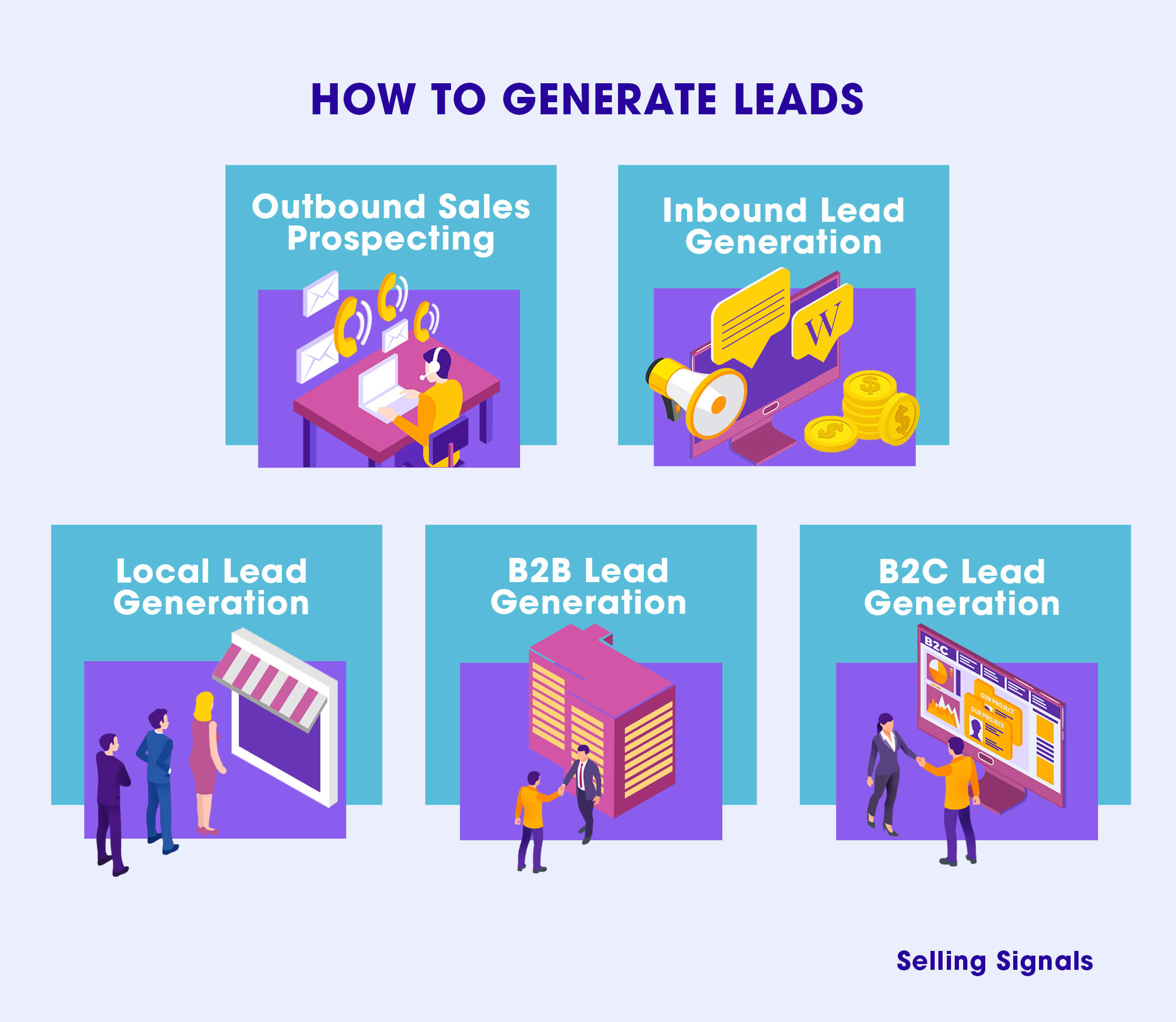-
News & Trends -
Sales -
Marketing Related Topics -
B2B Software Guides Related Topics -
Free Tools & Resources -
- About Us About Us


There are various ways to generate leads for your business, from inbound and outbound to local lead generation, each with its own specific strategies and steps. Your ideal method depends on your business’s unique sales process. To generate quality leads, first determine which method or blended approach makes the most sense for your business, then use the method's defined steps and strategies to bring in new leads.
Here are the five methods for generating leads for your business:
We’ll soon go over each of these five methods, their processes, and their strategies. First, however, let's talk about the basics of how to generate leads regardless of the specific method you choose.
No matter your method, the process of generating leads is all about introducing people to your brand, piquing their interest in a product or service, acquiring their contact information, and qualifying them as prospects whom you then start to nurture through your pipeline.
Below is the universal approach to find and qualify relevant leads for your business:
Create a description of the people or companies who will be most likely to buy your product or service so that you focus your resources on them. HubSpot’s Make My Persona tool can help you create yours.
While the finished product of your lead generation process will be different from those of other businesses, you’ll still all have followed this same high-level approach to crafting it. It’s a process that ensures your lead generation is focused on the right people and using effective strategies to get their attention, build desire, and convert them into qualified leads.
With this in mind, let's check out the five primary ways to generate quality leads:


Sales prospecting, aka outbound lead generation, is when businesses reach out directly to potential leads using cold calling, in-person networking, or other methods of outreach. It’s best for salespeople and businesses that want to take a proactive approach to generating leads, especially B2B companies. It’s also effective for B2C businesses selling big-ticket items that require more relationship-building.
The process of outbound lead generation involves creating a customer persona, finding and researching people who fit that description, conducting personalized outreach to get them to express interest in your offer, and finally, qualifying them as a sales lead over a phone call. After the lead is qualified, you’ll begin to nurture them to a close.
Here are the steps to the outbound lead generation process:
With outbound lead generation, you’re the master of your fate. Your success is based primarily on your persistence through rejection and on how well you can personalize your pitches and interactions to each specific buyer. This means doing research before contacting them is crucial.
The main differentiating factor between your process and those of other businesses using outbound lead generation will be the strategies you choose to use to connect with and pitch your potential leads. The main goal of these strategies is to book a longer meeting with the leads to qualify them.
Using a personalized cold call script, call and pitch people who have yet to communicate with your business, making sure to come across as a problem solver.
Write emails that introduce your product or service to a cold lead. Mention pain points that the recipient might have and then share how you solve it.
Engage with and direct message leads on social media platforms such as LinkedIn (best for B2B), Facebook, Instagram, and/or others according to where your ideal customers are.
Go door to door pitching your product or service to potential buyers. This is best for companies with a large, inclusive market or for those selling within a specific locality.
Attend trade shows, conferences, or local community events to meet potential buyers and interest them in your business offer.
Earn introductions to decision makers from prospective, current, or past clients through a methods like a referral program.
Your ideal strategy depends on your ideal customers and their preferences. For instance, if your target market skews younger, you may have trouble reaching them over the phone but an easier time getting their attention on social media.
For a closer look at the overall sales prospecting process, read our ultimate guide on how to generate outbound leads. There, you'll see how to choose the sales prospecting strategy that's best for you, along with key steps and more detailed articles on your chosen prospecting strategy.
Inbound, or online, lead generation is made up of various online methods that help potential customers discover your brand and turn into leads who provide their contact information. You can then use that information to reach out and nurture them toward a close. This method is best for marketing-focused teams that want to set up a system in which leads come to them.
Inbound lead generation begins by targeting people who fit your customer persona and attracting them to your brand by offering them relevant content, whether it’s in the form of blog posts, social media posts, or paid ads. As they engage with your brand, trust builds, and you drive them to a lead magnet — a free content upgrade like an ebook they can download in return for their contact information. Once they take this action and are qualified, they’ve officially become a marketing lead.
Here are the basic steps of inbound lead generation:
Most businesses can benefit from online lead generation, especially those that already prioritize marketing. It enables you to consistently target and attract high potential leads to your business without having to reach out to them directly. The process becomes almost passive once you get it up and running, besides the tweaking and optimizing you’ll perform to increase your conversions.
There are two umbrella strategies for online lead generation that differ in where you capture a lead’s contact information. The first is the social media method in which you capture contact information directly on social media platforms through native forms. The second is the more popular lead generation website method in which you direct leads to your website and capture their information there through embedded or pop-up forms.
Below are six sub-strategies to collect lead information via social media or your site:
Build a sales- or marketing-oriented site with a landing page that hosts your lead magnet and a form that captures incoming leads’ contact information.
Write free articles that answer your target audience's questions that they search on Google, and post them on your website.
Create an organic posting strategy on social media that leverages your blog content as well as other content-types.
Offer an enticing lead magnet to your audience, like a content upgrade, free trial, or free consultation.
Use social media ads to drive traffic to your lead magnet, or capture lead info directly using Facebook lead ads and LinkedIn lead gen forms.
Write ads for your business offering, then get them listed in the top 2–4 spots on Google's search engine results page by paying a certain fee per click.
There are countless ways to get people to visit your website and submit their contact information. The strategies you choose to employ depends on your business, your customers, and the amount of time and money you have to spend on lead generation.
We wrote an in-depth article on the various strategies you can choose from to create your customized online lead generation process. Give it a read to learn more about the steps to generate inbound leads and the specific strategies within each step.
Local lead generation represents the process and strategies that businesses with physical locations or local service offerings use to generate regional leads. Businesses can then use lead contact information to drive foot traffic to their brick and mortar location or contact for their local service offering. It's possible to use either regionally-focused inbound or outbound methods.
Local lead generation targets people in a certain area and offers them a lead magnet (e.g., discount, consultation, free product) in return for their contact information. You’ll host this magnet on a landing page with a form that potential leads can fill out with their information to receive the lead magnet. Then you send local traffic to that landing page using strategies like local search engine marketing (SEM), targeted social ads, organic social media, and more.
Here is the local lead generation process in a nutshell:
Typically, the end result of your local lead generation process shouldn’t just be to create one-time customers. It should be to create long-term customers you can continue to reach out to using the contact information they’ve provided, offering them deals, discounts, and other reasons to return to your business.
There are many strategies businesses employ to get their ideal leads onto their local landing page and into their store, from online tactics like local SEO and SEM to in-person ones like hosting community events. Here are some of the top strategies to generate local leads:
Optimize your business website’s ranking in the search results for regional people searching for what you offer. Do this by listing your business on local review sites like Yelp or Google My Business and accumulating positive reviews.
Run Google search ads targeting keywords related to your business so that if people search things like “Italian restaurant in {town name},” they’ll see your ad.
Run ads for your lead magnet across social platforms like Facebook. The ads will appear to people only in the region you define.
Get out into your area and talk to people about your business, or host or sponsor fun events in your community.
These strategies are a great starting point. There are also other strategies such as referrals, in-store promotions, and social media management that could be even more effective for your business.
In our local lead generation ultimate guide, we cover all of these aforementioned strategies along with software that you can use to optimize your process. Check it out to evaluate each strategy in depth and decide which is the best fit for your local business.
B2B lead generation refers to the process and strategies that salespeople use to attract decision makers from good-fit companies to their business and to convert them into qualified prospects whom they can nurture to a close. B2B businesses involved in lead generation can use inbound, outbound, or a mix of both methods. Local B2B businesses may also choose to incorporate local lead generation strategies.
The process of B2B lead generation begins with defining which types of companies and decision makers within those companies you are going to focus your lead generation efforts on. Then you’ll pick between (or blend) online, local, and outbound lead generation methods to attract these decision makers to your business and get them to express interest in your offer. From there, you’ll qualify the leads to assess if they’re a good fit to buy your product or service.
Here is the general process for B2B lead generation:
Qualifying the lead is especially important in B2B sales where the sales cycles are typically long or complicated. You want to avoid letting in unqualified leads who will drain your sales team’s time but never buy the solution because they lack the right budget, authority, or needs. You want to let in leads with a high likelihood to buy whom you can more easily nurture to a close.
B2B companies invest a lot of resources into generating leads for their businesses. There are three overarching strategies for doing so: inbound, outbound, and blended. We've covered them above in this article, but here’s a quick description of each:
Use online methods like SEO, PPC ads, or social media marketing to direct decision makers to your website where you collect their contact information in return for a lead magnet (ebook, checklist, free demo, etc.).
Compile a list of companies that fit your ICP. Find the decision makers within the companies and their contact information. Then reach out to them to get them to express interest in your business offering.
This is a mix between inbound and outbound lead generation. It’s recommended for those who want to fill their pipeline quickly by simultaneously attracting leads and reaching out to others.
B2B lead generation is crucial to the health of any B2B company’s sales pipeline. A healthy influx of curious decision makers from target companies will keep your salespeople happy and your bottom line growing.
To learn more about this type of lead generation, read our article on B2B lead generation, where we give you some top B2B lead generation tools and strategies plus companies that can help you generate leads.
B2C lead generation is the process a company uses to identify individual consumers, attract or reach out to them, and convert them into prospects. This often involves inbound methods like offering target customers educational online content to make them aware of your brand, then gathering contact information through a lead magnet and sending email campaigns about your product or service. For big-ticket items, it also might involve direct outreach.
To generate B2C leads, you must first understand your ideal customer — the individuals who have the needs their product or service satisfies. That way, you can find them and market to them appropriately. Then, using strategies from online ones like content marketing to outbound ones like cold emailing, you attract them to your business. Lastly, you assess the data they’ve provided you or ask them questions over the phone to see if they’re a good fit for nurturing.
Here are the three overarching steps of B2C lead generation:
The best way to consistently generate high-quality B2C leads is by continuously offering valuable insights and content to the individuals to whom you’re marketing or selling. That way, you’ll earn their trust, and as your virtual relationship grows, they’ll become increasingly likely to purchase your products or services. Because B2C products and services tend to be more affordable than B2B items, some leads will purchase immediately.
B2C brands can generate leads in three different ways and have the ability to use all three or a blend of two if it works for their needs. We've gone over them in detail in the sections above, but here’s a brief summary of the four strategies:
Use online methods like SEO or paid social ads to attract leads to a landing page where they collect contact information.
Cold call, cold email, and network with leads to get them to express interest.
This means a mix of inbound and outbound lead generation, such as content marketing and cold calling.
Attract regional leads to your business with local SEO, local SEM, and other tactics.
If your company has no need for a sales representative to speak with the lead before they become a customer, opt for inbound lead generation. If it’s the opposite, have sales reps do some outbound lead generation either as a standalone lead generation strategy or to assist your inbound lead generation efforts. Any brick and mortar store should be participating in local lead generation methods to get regional leads interested in visiting their store.
Regardless of which type of lead generation strategy you’re using, the process is all about building interest in your brand and capitalizing on that interest to get ideal customers to opt in to your sales funnel, either by filling out an online form for a lead magnet or by responding to your email saying they want to learn more. Now that you have the big picture, go check out one of our articles about the lead generation type that sounded most useful for your business.


Sam is a former SaaS sales rep turned freelance writer. He spent his career selling real estate technology to C-suite executives before switching over to blogging, where he now covers sales, marketing, and small business topics. Sam specializes in lead generation, lead nurturing, and deal closing articles for Selling Signals. When he’s not researching the latest sales trends, he’s either penning short stories, hiking, or reading in NYC’s Washington Square Park.

Selling Signals delivers actionable advice for sales and marketing professionals. Learn strategies that help you hit targets, strengthen customer relationships, and win more business. Get expert advice on lead generation, sales processes, CRM software, sales management, and account management directly to your inbox.
Property of TechnologyAdvice. © 2025 TechnologyAdvice. All Rights Reserved
Advertiser Disclosure: Some of the products that appear on this site are from companies from which TechnologyAdvice receives compensation. This compensation may impact how and where products appear on this site including, for example, the order in which they appear. TechnologyAdvice does not include all companies or all types of products available in the marketplace.